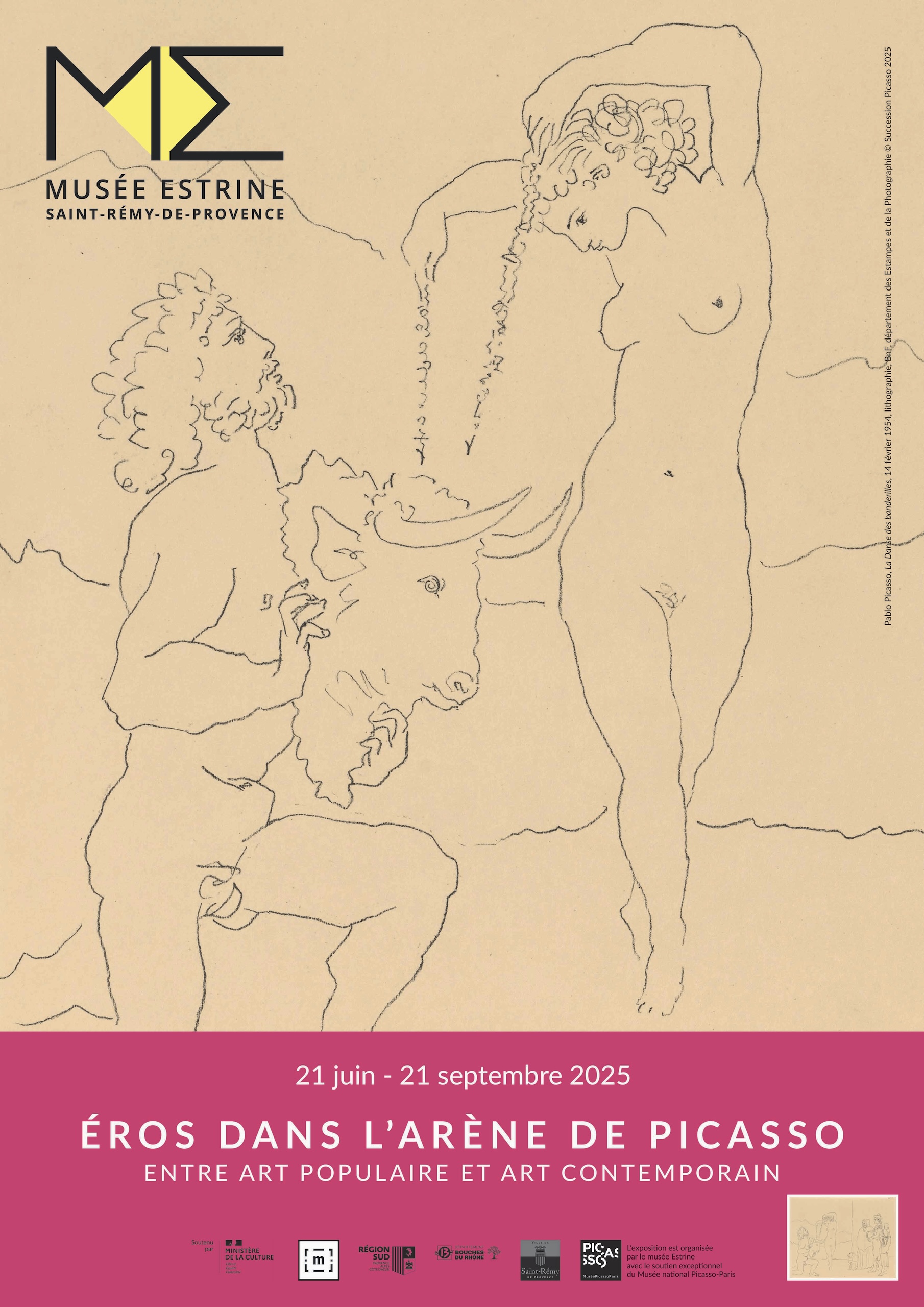WOMEN AT THE PALCO
« If women didn’t attend bullfights, bullfighters wouldn’t exist.
Luis-Miguel Dominguín, matador, Toros y Toreros, 1981
The theme of women watching bullfights from a box (palco) is a recurring motif in costumbrismo. From the drawings of 1905 to the linocut poster of 1954 in the form of a letter of mourning for Françoise Gilot’s farewell, or the poster for the Galerie des Ponchettes in 1960, Picasso returned to the motif of the woman on the palco balcony, watching the fight from her vantage point. As usual, he drew inspiration both from the customs of the time – under the arches of the bullring, chairs were used to seat women, sometimes with their children, and standing men – and from pictorial memories such as Las Majas en el balcón painted by Goya in 1812, or traditional bullfighting posters. As early as 1888, Van Gogh had depicted women in traditional dress in the foreground of Arènes in Arles. Picasso uses all this imagery in the service of his own vision of the woman in the arena, whose overhanging gaze consecrates the bullfighter’s triumph, eroticizing the stakes of combat as immortalized by Bizet in the famous aria from Carmen: “Toreador on guard, toreador / And remember, remember as you fight / That a black eye is watching you / And that love awaits you.”
Picasso illustrated Mérimée’s book in 1949, which was reprinted in 1957 in Le Carmen des Carmen, whose prints alternate feminine and bullfighting evocations, recalling the correspondences between bullfighting and love relationships that form the fabric of both the book and the opera. An aquatint contrasts the profiles of a matador and a woman in a mantilla on the balcony. The image escapes folkloristic mawkishness by scribbling orange over the visible weft of the first printing, drawing a palimpsest mirroring all the textual, pictorial, lyrical and cinematographic interpretations the text has generated.
FRAUEN IM „PALCO“
« Wenn die Frau nicht an den Stierkämpfen teilnehmen würde, gäbe es keine Toreros. Ich zumindest. «
Luis-Miguel Dominguín, Matador, Toros y Toreros, 1981
Das Thema der Frau, die den Kampf in der Arena von einer Loge (palco) aus beobachtet, ist ein wiederkehrendes Motiv im Costumbrismo. Von den Zeichnungen aus dem Jahr 1905 bis zum Linolschnitt-Plakat in Form eines Trauerbriefs für Françoise Gilots Abschied 1954 oder dem Plakat für die Galerie des Ponchettes 1960 kam Picasso immer wieder auf das Motiv der Frau auf dem Balkon des Palcos zurück, die den Kampf aus ihrer Perspektive von oben betrachtet und aus der Vogelperspektive erfasst. Wie üblich ließ er sich sowohl von den damaligen Gepflogenheiten inspirieren – unter den Arkaden der Arenen standen Stühle für Frauen, manchmal mit ihren Kindern, und stehende Männer – als auch von bildlichen Erinnerungen wie Goyas Las Majas en el balcón aus dem Jahr 1812 oder traditionellen Stierkampfplakaten. Van Gogh hatte bereits 1888 in Arènes in Arles Frauen in traditionellen Gewändern in den Vordergrund gestellt. Picasso nutzt all diese Bilder für seine eigene Vision der Frau in der Arena, deren überhängender Blick den Triumph des Toreros festschreibt und die Herausforderungen des Kampfes erotisiert, wie sie Bizet in seiner berühmten Arie aus Carmen verewigt hat: „Toreador in Deckung, Toreador / Und denk daran, ja denk daran, während du kämpfst /Dass ein schwarzes Auge dich anschaut / Und dass die Liebe auf dich wartet ».
Picasso illustrierte Mérimées Buch 1949, das 1957 in Le Carmen des Carmen wieder aufgegriffen wurde. In den Drucken wechseln sich Frauen- und Stierkampfdarstellungen ab, die an die Entsprechungen zwischen Stierkampf und Liebesbeziehungen erinnern, die den Rahmen des Buches wie der Oper bilden. Eine Aquatinta stellt die Profile eines Matadors und einer Frau mit Mantilla auf dem Balkon gegenüber. Das Bild entgeht der folkloristischen Rührseligkeit durch die Kritzeleien, die das sichtbare Raster des ersten Drucks orange umranden und ein spiegelbildliches Palimpsest all dessen zeichnen, was der Text an textlichen, malerischen, lyrischen und filmischen Interpretationen hervorgebracht hat.
MUJERES EN EL PALCO
«Si las mujeres no asistieran a las corridas de toros, los toreros no existirían».
Luis-Miguel Dominguín, matador, Toros y Toreros, 1981
El tema de las mujeres que asisten a las corridas de toros desde un palco es un motivo recurrente en el costumbrismo. Desde los dibujos de 1905 hasta el cartel linograbado de 1954 en forma de carta de duelo por la despedida de Françoise Gilot, o el cartel de la Galerie des Ponchettes de 1960, Picasso volvió a retomar el motivo de la mujer en el palco, observando la lidia desde arriba, desde su punto de vista. Como de costumbre, se inspiró tanto en las costumbres de la época -bajo los arcos de la plaza de toros se colocaban sillas para las mujeres, a veces con sus hijos, y los hombres de pie- como en recuerdos pictóricos como Las Majas en el balcón pintado por Goya en 1812 o los carteles taurinos tradicionales. Ya en 1888, Van Gogh había representado a mujeres con trajes tradicionales en el primer plano de Arènes, en Arlés. Picasso utiliza toda esta imaginería al servicio de su propia visión de la mujer en el ruedo, cuya mirada en volandas consagra el triunfo del torero y erotiza lo que está en juego en el combate, tal como lo inmortalizó Bizet en la célebre aria de Carmen: «Torero en guardia, torero. Y recuerda, recuerda mientras toreas / Que un ojo negro te vigila / Y que el amor te espera.»
Picasso ilustró el libro de Mérimée en 1949, que fue reeditado en 1957 en Le Carmen des Carmen, cuyos grabados alternan evocaciones femeninas y taurinas, recordando las conexiones entre las relaciones taurinas y amorosas que forman el tejido tanto del libro como de la ópera. Un aguatinta contrasta los perfiles de un matador y de una mujer con mantilla en el balcón. La imagen evita la sensiblería folletinesca garabateando en naranja sobre la trama visible de la primera impresión, dibujando un palimpsesto que refleja todas las interpretaciones textuales, pictóricas, líricas y cinematográficas que ha generado el texto.
